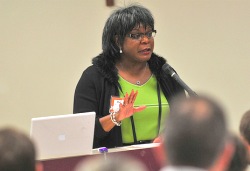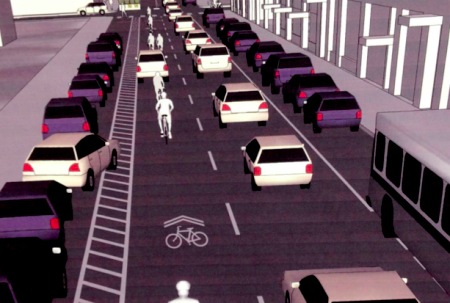
(Photo © J. Maus/BikePortland)
The citizen-led committee tasked with how to improve bike access and traffic safety on N. Williams Avenue met for the 14th time yesterday. And as the clock winds down on making an official recommendation to PBOT on how to move forward, they appear no closer to reaching consensus.
Committee member Steve Bozzone, summed up his thoughts about the meeting on Twitter last night: “Overall there remains broad agreement about safety outcomes on Williams Ave, but process to decide on options is muddled, confusing.” In addition, it appeared that the specter of mistrust of PBOT and concerns that community feedback was not being heard, have reappeared.
The goal of the meeting was to move forward on feedback of the design options PBOT presented with at the last meeting on February 21st. PBOT also introduced new designs yesterday that included an interesting “shared” left lane option…

This design is considered a variation of “Option 1” (a left-side cycle track and one-lane for motor vehicles the entire way) and was put forward as a way to alleviate concerns about having one lane of motor vehicle traffic in the busy stretch of Williams between Cook and Skidmore (known as Segment 4).
PBOT project manager Ellen Vanderslice described this option as “one-lane plus.” Unlike a cycle-track, it wouldn’t be dedicated solely to bike traffic, it would be a narrow lane (nine feet wide) that bikes would share with cars. Cars would enter the lane to park, to pass another car, or to turn left. PBOT says they’d mark the lane with a sharrow and there would be a hard median in the parking lane in the northwest corner of each intersection to prevent through car traffic (see graphic). In some ways, it seems like it’d be a neighborhood greenway-like feeling on a main street. Here’s another look…

This left-side shared lane would be a downgrade (in terms of bike access and safety gains) from the left-side cycle track; but it’s a compromise solution to people with concerns about traffic congestion and auto access in Segment 4.
Another option put on the table was a left-side buffered bike lane with the shared lane in Segment 4.
After discussing the new design options and hearing about development/zoning issues from a Bureau of Planning and Sustainability rep, the chair of the committee, Debora Hutchins, said, “I’ve heard from many of you that you want to move past disc and move toward a recommendation.”
At that point, several committee members voiced concerns with the left-side cycle-track idea. Jrdn Freeauf, a daily bike rider who works at a cabinet-making shop on Williams, shared several concerns. His company’s delivery trucks, Freeauf said, might end up blocking the lane. “My friends are the cyclists… But the last thing I want are cyclists giving me the finger for blocking the lane.”
Another committee member (who is also daily bike rider), Shara Alexander, agreed with Freeauf. “[With the left side cycle track] you eliminate the bus/bike conflict, but you throw in a whole bunch of new conflicts.”
With momentum waning for the left side cycle track and uneasiness about how it might work, the committee spent quite a bit of time discussing whether or not PBOT could just experiment with the concept first, before making it a permanent fix.
As feedback from the committee went around the table, Jarrell Waddell, assistant pastor at Life Change Christian Center, spoke up in opposition to the one-lane option. (Note: Mr. Waddell is the man who joined me on OPB radio back in July.). Waddell said it is “frustrating” to him that the concerns of people who drive motor vehicles on Williams “are not represented here.”
“I believe there’s a contingency of people that want to use the street that may not be bicycle users,” said Waddell. His main contention is that since the “predominant mode is vehicles at all times of the day” the one-lane option shouldn’t be on the table. “I don’t want to spoil this… But there are people who want to drive on the street as well,” added Waddell. And, given the booming development on the street, by 2035, he said “that’s going to be a nightmare.”
Waddell’s stance didn’t seem to have any support around the table. The two committee members that responded both disagreed with him.
But another woman, Noni Causey, openly questioned whether the City had taken community feedback opposing the one-lane option into account. “Whatever happened to those community meetings and input people gave between one lane and two lanes,” she asked, “Do those people count?”
Committee Chair Hutchins quickly pointed out to Causey that community feedback was used to come up with the list of project outcomes, a list that is supposed to drive all design decisions from here on out.
But even though the committee agrees about the importance of safety, whether or not they can compromise on an actual design and agree to a recommendation for PBOT before time expires, remains to be seen.
After 13 months of meetings, Chair Hutchins said, “I don’t think we’re at a point to make a decision.” “We all need to go back to our places and look at these options… And evaluate what is the most comfortable thing you could realistically live with.”
The next meeting is on March 20th.
